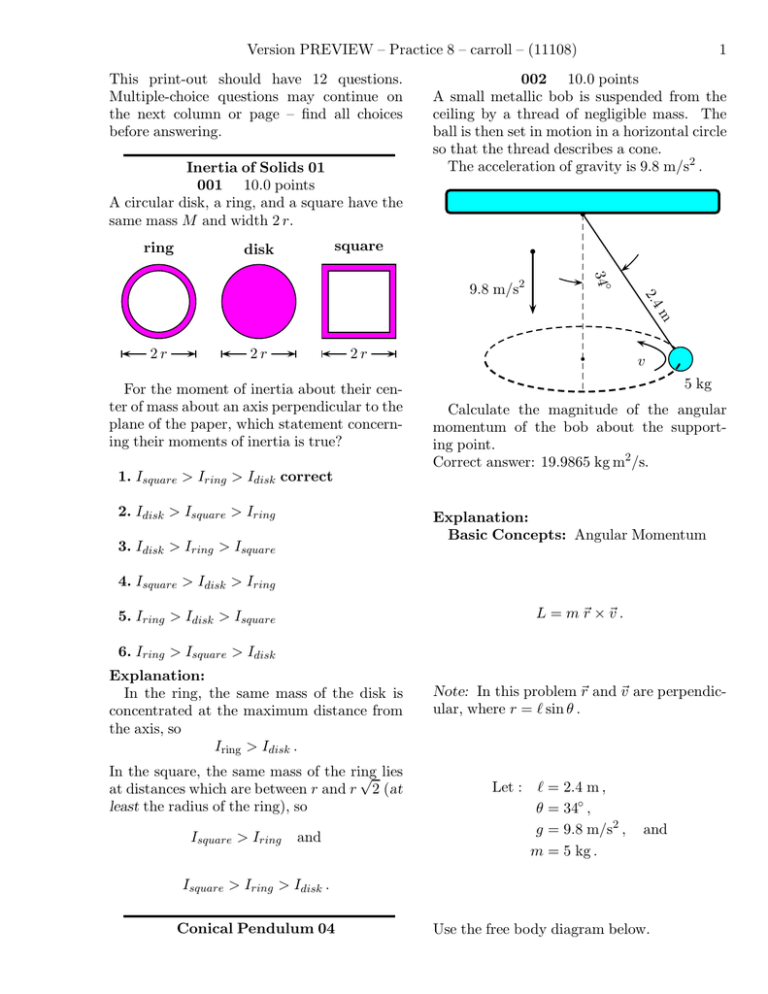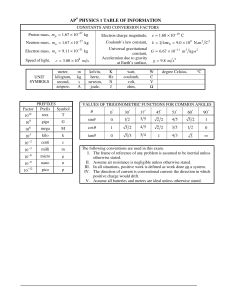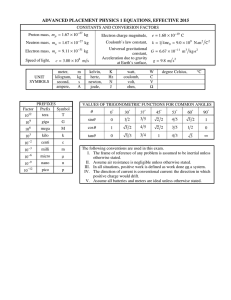Version PREVIEW – Practice 8 – carroll – (11108) 1 This print
advertisement

Version PREVIEW – Practice 8 – carroll – (11108) This print-out should have 12 questions. Multiple-choice questions may continue on the next column or page – find all choices before answering. Inertia of Solids 01 001 10.0 points A circular disk, a ring, and a square have the same mass M and width 2 r. ring 1 002 10.0 points A small metallic bob is suspended from the ceiling by a thread of negligible mass. The ball is then set in motion in a horizontal circle so that the thread describes a cone. The acceleration of gravity is 9.8 m/s2 . square disk ◦ 34 2. 4 9.8 m/s2 m 2r 2r 2r For the moment of inertia about their center of mass about an axis perpendicular to the plane of the paper, which statement concerning their moments of inertia is true? 1. Isquare > Iring > Idisk correct 2. Idisk > Isquare > Iring v 5 kg Calculate the magnitude of the angular momentum of the bob about the supporting point. Correct answer: 19.9865 kg m2 /s. Explanation: Basic Concepts: Angular Momentum 3. Idisk > Iring > Isquare 4. Isquare > Idisk > Iring L = m ~r × ~v . 5. Iring > Idisk > Isquare 6. Iring > Isquare > Idisk Explanation: In the ring, the same mass of the disk is concentrated at the maximum distance from the axis, so Iring > Idisk . In the square, the same mass of the ring √ lies at distances which are between r and r 2 (at least the radius of the ring), so Isquare > Iring and Note: In this problem ~r and ~v are perpendicular, where r = ℓ sin θ . Let : ℓ = 2.4 m , θ = 34◦ , g = 9.8 m/s2 , m = 5 kg . and Isquare > Iring > Idisk . Conical Pendulum 04 Use the free body diagram below. Version PREVIEW – Practice 8 – carroll – (11108) θ T 2 bar is fastened by a pivot at one end to a wall which is at an angle θ with respect to the horizontal. The bar is held horizontal by a vertical cord that is fastened to the bar at a distance a distance xcord from the wall. A mass m2 is suspended from the free end of the bar. T θ mg Solution: The second Newton’s law in the vertical and horizontal projections, respectively, in our case reads T cos θ − m g = 0 T sin θ − m ω 2 ℓ sin θ = 0 , where T is the force with which the wire acts on the bob and the radius of the orbit is R = ℓ sin θ. From this system of equations we find r g ω= ℓ cos θ s (9.8 m/s2 ) = (2.4 m) cos(34◦ ) = 2.21932 rad/s . The angular momentum L then will amount to L = m ω (ℓ sin θ)2 r g ℓ3 2 = m sin θ cos θ 2 = (5 kg) sin (34◦ ) s (9.8 m/s2 ) (2.4 m)3 × cos(34◦ ) = 19.9865 kg m2 /s . Beam on a Slanted Wall 01 003 (part 1 of 2) 10.0 points A solid bar of length L has a mass m1 . The m1 xcord m2 L Find the tension T in the cord. 1. T = 0 1 L 2. T = m1 + m2 g correct 2 xcord 3. T = (m1 + m2 ) g cos θ 1 L 4. T = m1 + m2 g cos θ 2 xcord g L 5. T = (m1 + m2 ) x 2 cord L 1 g 6. T = m1 + m2 2 xcord 1 L 7. T = m1 + m2 g cos θ 2 xcord L 1 g sin θ 8. T = m1 + m2 2 xcord L 1 m1 + m2 g sin θ 9. T = 2 xcord 10. T = (m1 + m2 ) g sin θ Explanation: Basic Concepts: Static Equilibrium: X F =0. X τ =0. Torque: τ = r⊥ F = r F⊥ Version PREVIEW – Practice 8 – carroll – (11108) We can begin by either summing the torques or the forces and setting them equal to zero. In this case, since we know little about the reaction force between the bar and the wall, it is easiest to begin by examining the torques around the connection between the bar and the wall, because the reaction forces will produce no torques around that point. X L τ = −L m2 g + xcord T − m1 g = 0 . 2 Solving this for T gives L 1 m1 + m2 T = g . 2 xcord 004 (part 2 of 2) 10.0 points Find the the horizontal component of the force exerted on the bar by the wall. (Take the positive direction to be right.) 1. Fx = (m1 + m2 ) g cos θ 2. Fx = (m1 + m2 ) g sin θ 1 L 3. Fx = m1 + m2 g cos θ 2 xcord g L 4. Fx = (m1 + m2 ) x 2 cord 1 L 5. Fx = m1 + m2 g sin θ 2 xcord L 1 g 6. Fx = m1 + m2 2 xcord L 1 m1 + m2 g sin θ 7. Fx = 2 xcord 8. Fx = 0 correct L 1 m1 + m2 9. Fx = g 2 xcord L 1 g cos θ 10. Fx = m1 + m2 2 xcord Explanation: In general, there will be a horizontal reaction force Rx at the connection between an object and a wall. However, none of the other forces in this situation act in the horizontal direction. Therefore: X Fx = Rx = 0 . 3 Rotation of a Solid Disk 03 005 10.0 points A uniform solid disk of radius 6.85 m and mass 34.8 kg is free to rotate on a frictionless pivot through a point on its rim. Pivot 6.85 m If the disk is released from rest in the position shown by the solid circle, what is the speed of its center of mass when the disk reaches the position indicated by the dashed circle? The acceleration of gravity is 9.8 m/s2 . Correct answer: 9.4608 m/s. Explanation: Let : r = 6.85 m and m = 34.8 kg . From the parallel axis theorem 3 1 I = M R2 + M R2 = M R2 . 2 2 so the final kinetic energy is 1 3 2 ω2 Kf = MR 2 2 1 3 M v2 = 2 2 3 3 = M v 2 = M R2 ω 2 . 4 4 From conservation of energy (K + U )i = (K + U )f 1 0 + M g R = I ω2 2 3 M g R = M R2 ω 2 4 r 4g ω= 3R Version PREVIEW – Practice 8 – carroll – (11108) Hence the velocity of the center of mass is vcm = ω R r Rg 3 r (6.85 m) (9.8 m/s2 ) =2 3 = 9.4608 m/s . =2 Alternate Solution The kinetic energy is Kftotal = Kfrotational + Kfcm linear 4 Explanation: From conservation of energy we have Ui = Ktrans,f + Krot,f 1 1 M g h = M v2 + I ω2 2 2 2 1 2 v 1 2 2 MR = Mv + 2 2 5 R2 r 7 10 = M v 2 .v1 = gh 10 7 r 10 (9.8 m/s2 ) (1.6 m) = 7 = 4.73286 m/s . 1 1 1 2 M R ω2 + M v2 Kf = 2 2 2 1 1 1 = M v2 + M v2 2 2 2 3 3 = M v 2 = M R2 ω 2 . 4 4 007 (part 2 of 2) 10.0 points Calculate the speed of the sphere if it reaches the bottom of the incline by slipping frictionlessly without rolling. Correct answer: 5.6 m/s. Explanation: From conservation of energy we have keywords: Solid Sphere on an Incline 04 006 (part 1 of 2) 10.0 points A solid sphere of radius 34 cm is positioned at the top of an incline that makes 26 ◦ angle with the horizontal. This initial position of the sphere is a vertical distance 1.6 m above its position when at the bottom of the incline. The sphere is released and moves down the incline. 34 cm M µ 26 ◦ 1.6 m ℓ Calculate the speed of the sphere when it reaches the bottom of the incline if it rolls without slipping. The acceleration of gravity is 9.8 m/s2 . The moment of inertia of a sphere with respect to an axis through its center is 2 M R2 . 5 Correct answer: 4.73286 m/s. Ui = Ktrans,f 1 M g h = M v2 2 p v2 = 2 g h q = 2 (9.8 m/s2 ) (1.6 m) = 5.6 m/s . keywords: /* If you use any of these, fix the comment symbols. g=9.8 ; —* u=m/s2 ∗ |h = 6.626075e − 34; | ∗ u = J s ∗ |Someof yourvariablesresembleconstants. Airplane Momentum 008 (part 1 of 2) 10.0 points An airplane of mass 24172 kg flies level to the ground at an altitude of 16 km with a constant speed of 172 m/s relative to the Earth. What is the magnitude of the airplane’s angular momentum relative to a ground observer directly below the airplane in kg·m2 /s? Correct answer: 6.65213 × 1010 kg · m2 /s. Version PREVIEW – Practice 8 – carroll – (11108) Explanation: Since the observer is directly below the airplane, L = hmv 009 (part 2 of 2) 10.0 points Does this value change as the airplane continues its motion along a straight line? 1. Yes. L changes with certain period as the airplane moves. 2. Yes. L decreases as the airplane moves. First, calculate the planet’s angular momentum (relative to its spin axis) before the impact. Correct answer: 1.25797 × 1033 kg m2 /s. Explanation: Basic Concept: A rigid body rotating around a fixed axis has angular momentum L=I ×ω where I is the body’s moment of inertia about the axis of rotation. Approximating the planet as a solid ball of uniform density, its moment of inertia is 3. Yes. L increases as the airplane moves. 5. Yes. L changes in a random pattern as the airplane moves. Explanation: L = constant since the perpendicular distance from the line of flight to Earth’s surface doesn’t change. Asteroid Collision 010 (part 1 of 3) 10.0 points Consider an Earth-like planet hit by an asteroid. The planet has mass Mp = 6.72 × 1023 kg and radius Rp = 6.55 × 106 m, and you may approximate it as a solid ball of uniform density. It rotates on its axis once every T = 16 hr. The asteroid has mass Ma = 3.99 × 1017 kg and speed va = 22500 m/s (relative to the planet’s center); its velocity vector points θ = 70◦ below the Eastward horizontal. The impact happens at an equatorial location. The picture below shows the view from above the planet’s North pole: vm θ R 2 M R2 5 = 1.15322 × 1037 kg m2 . Ip = 4. No. L = constant. correct ω 5 Its angular velocity before the impact is 2π T = 0.000109083 rad/s , so L=I ×ω =I ×ω = (1.15322 × 1037 kg m2 ) ×(0.000109083 rad/s) ω= = 1.25797 × 1033 kg m2 /s . 011 (part 2 of 3) 10.0 points Calculate the asteroid’s angular momentum relative to the planetary axis. Correct answer: 2.01117 × 1028 kg m2 /s. Explanation: Approximating the asteroid as a pointlike particle, its angular momentum is ~a = R ~ × Ma ~va L ~ is the asteroid’s radius vector and where R Ma ~va is its linear momentum vector. At the moment of impact, both the radius ~ and the momentum vector Ma~va vector R of the asteroid lie in the planet’s equatorial plane. Consequently, their vector product is perpendicular to the equatorial plane and Version PREVIEW – Practice 8 – carroll – (11108) parallel to the planet axis. Because the horizontal component of the asteroid’s velocity is directed Eastward — the same as the planet’s rotation — the asteroid’s angular momentum ~ a has the same direction as the planet’s anL ~ p. gular momentum L In magnitude, La = Rp Ma × horizontal component of va = Rp Ma × va cos θ 6 and since we assume unchanged moment of inertia Ip′ = Ip , it follows that after the impact, the planet rotates at new angular velocity L′p ω = Ip ′ =ω+ Rp Ma va cos θ . Ip In other words, 6 = (6.55 × 10 m) ×(3.99 × 1017 kg) (22500 m/s) cos(70◦ ) = 2.01117 × 1028 kg m2 /s . 012 (part 3 of 3) 10.0 points The impact is totally inelastic — the asteroid is stuck in the planet’s crust. But thanks to the asteroid’s angular momentum, the planet rotates faster after the impact than it did before. By how many seconds has the collision shortened the planetary day? For simplicity, ignore the effect of the asteroid’s mass on the planet’s moment of inertia and assume before I after = Iplanet . Warning: At intermediate stages of this calculation, do not round off intermediate results and keep at least 7 significant digits. Correct answer: 0.920862 s. Explanation: The net angular momentum is conserved in this collision, so after the impact the planet (with the asteroid stuck in its crust) has ~ ′p = L ~p +L ~a . L ~ Focusing on the Northward component of L (the other two components vanish), we have L′p = Lp + La = Ip ω + Rp Ma va cos θ . At the same time, L′p = IP′ ω ′ , ∆ω = ω ′ − ω Rp Ma va cos θ = Ip 5 Ma va cos θ = 2 Mp Rp = 1.74396 × 10−9 rad/s . In terms of the planetary day, this change means −∆T = T − T ′ 2π 2π = − ′ ω ω 2 π(ω ′ − ω) = ω ω′ 2 π ∆ω 1 = ω + ∆ω ω 2 π (1.74396 × 10−9 rad/s) = (0.000109085 rad/s) 1 × (0.000109083 rad/s) = 0.920862 s , where ω + ∆ω = (0.000109083 rad/s) +(1.74396 × 10−9 rad/s) = 0.000109085 rad/s .





